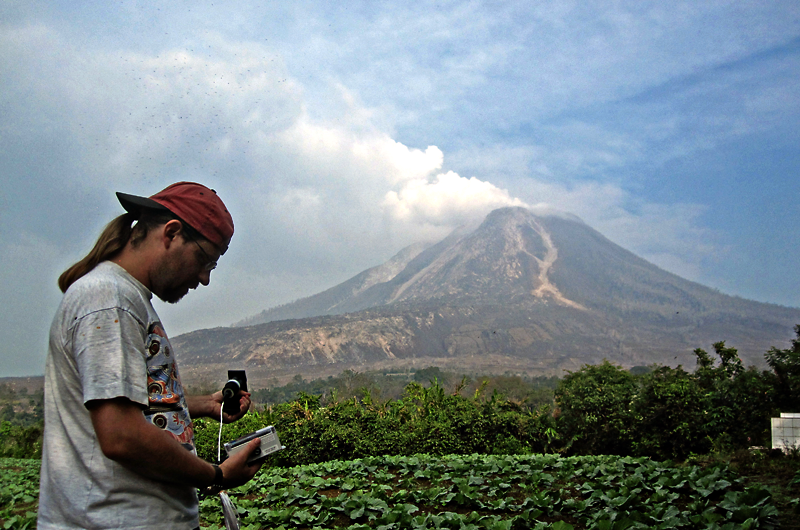Loÿc Vanderkluysen, PhD, who recently joined Drexel as an assistant professor in Department of Biodiversity, Earth and Environmental Science in the College of Arts and Sciences, returned Friday from fieldwork in Indonesia monitoring the active Sinabung volcano – just in time to learn of the tragic events unfolding in Japan with the sudden eruption of Mt. Ontake.
Vanderkluysen can provide insight into the science of volcanos and what challenges remain during the ongoing rescue effort in Japan. Below are his responses to some common questions.
Why did this happen? Did the agency in charge of volcano monitoring in Japan make a massive blunder?
It doesn’t appear that way. Japan has one of densest volcano monitoring systems in the world, and a very sophisticated warning system. The reality is that the eruption simply didn’t have precursors.
Don’t all eruptions have precursors?
No, not necessarily. Modern volcano monitoring tools are designed to detect the presence and motion of magma (which is hot, molten rock) inside volcanoes. However, on occasion, volcanoes can have eruptions where no magma is involved. Many volcanoes have active hydrothermal systems, which is simply heated groundwater. A number of factors can lead to hydrothermal reservoir pressures increasing, to the point where they can explode. This is termed a “phreatic” eruption.
In the coming days, I expect volcanologists to look at samples from the eruption of Ontake-san, to look for any sign that fresh magma was involved. I suspect that they won’t find any. The absence of precursors and the apparent steam-heavy plume produced by the eruption seem to indicate that Mt. Ontake experienced a phreatic eruption.
Are phreatic eruptions common?
They are rather common, and the absence of obvious precursors represent a major challenge for the volcanological community. This is especially true given that many dormant volcanoes are popular touristic spots… and can also host active hydrothermal systems. In New Zealand in 2007, a skier, who was staying overnight in a lodge at the summit Mt Ruapehu, got his leg crushed by a block ejected during a phreatic eruption. Such eruptions without precursors have come to be known as “blue sky” eruptions there, and have occurred five times in the last 45 years at that volcano. Last year, five hikers got killed by a phreatic eruption on Mayon volcano in the Philippines.
Are all phreatic eruptions this big?
In the world of phreatic eruptions, it appears that Saturday’s in Japan was a relatively large one. However, phreatic eruptions tend to be very small compared to their regular volcanic equivalents.
What are the main hazards associated with phreatic eruptions?
There are two, principally: large blocks falling out of the sky, and inhalation of ash. During phreatic explosions, large blocks (that can be the size of a piano or a small car) are ejected in the air and can travel typically no more than a mile or two from the eruption source. Volcanologists working on active volcanoes have taken the habit of wearing a helmet, and tourists hiking on dormant volcanoes should do the same. Volcanic ash is composed of very small particles of volcanic rocks (smaller than 2mm, and commonly around 100 microns – that’s 1/500th of an inch). Inhaling large amounts of volcanic ash can lead to suffocation, which seems to have been a major component in the disaster at Ontake volcano. Wearing a dust mask helps or, in the absence of one, covering the nose and mouth with a wet piece of clothing.
People should be reminded that volcanic ash can be very heavy, and impose a heavy load on structures when accumulating on the roof. Seeking shelter should be a temporary solution, as it is known that roof collapse has traditionally been a major source of fatalities during volcanic eruptions.
What issues will first responders encounter during relief efforts?
The first issue will be the accumulation of ash. Approaching the area by helicopter will be complicated, as the freshly deposited ash can be remobilized, and choke and damage engines. Approaching on foot will also be made difficult by the presence of ash.
The second issue will be the steam plume. Even though the eruption appears to be over, a steam plume continues to cloud the volcano summit. It’s likely that a number of toxic gases are currently being emitted at dangerous levels, particularly the poisonous hydrogen sulfide (the “rotten egg” smell), and possibly sulfur dioxide (which is an irritant). It’s been reported that rescue efforts had to be put on hold for a time on Sunday, both because of the ash and the presence of a (unspecified) “toxic gas”.
That said, the situation remains volatile and it can’t be ruled out that more phreatic eruptions will occur in the next few days. This could affect further rescue efforts, as well as the safety of rescue workers.
About Loÿc Vanderkluysen’s research: During his Sept. 2014 fieldwork with colleagues Brett Carr from Arizona State University and Bima Eko Dhanu of Gadjah Mada University, Vanderkluysen monitored the ongoing eruption at Sinabung volcano, in northern Sumatra. After ten centuries of quiescence, Sinabung volcano started erupting in December 2013, spewing a thick, viscous lava flow on its southern flank, which has now reached 2.8 km (1.7 mi) in length. Ten months into the eruption, the lava flow’s advance has slowed down considerably, giving local populations a false sense of security. The flow’s steep flanks remain highly unstable, and pyroclastic flows triggered by rock collapse are common. Pyroclastic flows are one of the most devastating volcanic hazards: they consist of a fast-moving cloud of hot volcanic ash, capable of transporting large boulders at its base. Fatal pyroclastic flows occurred at Sinabung in February 2014.
Note : The above story is based on materials provided by Drexel University










